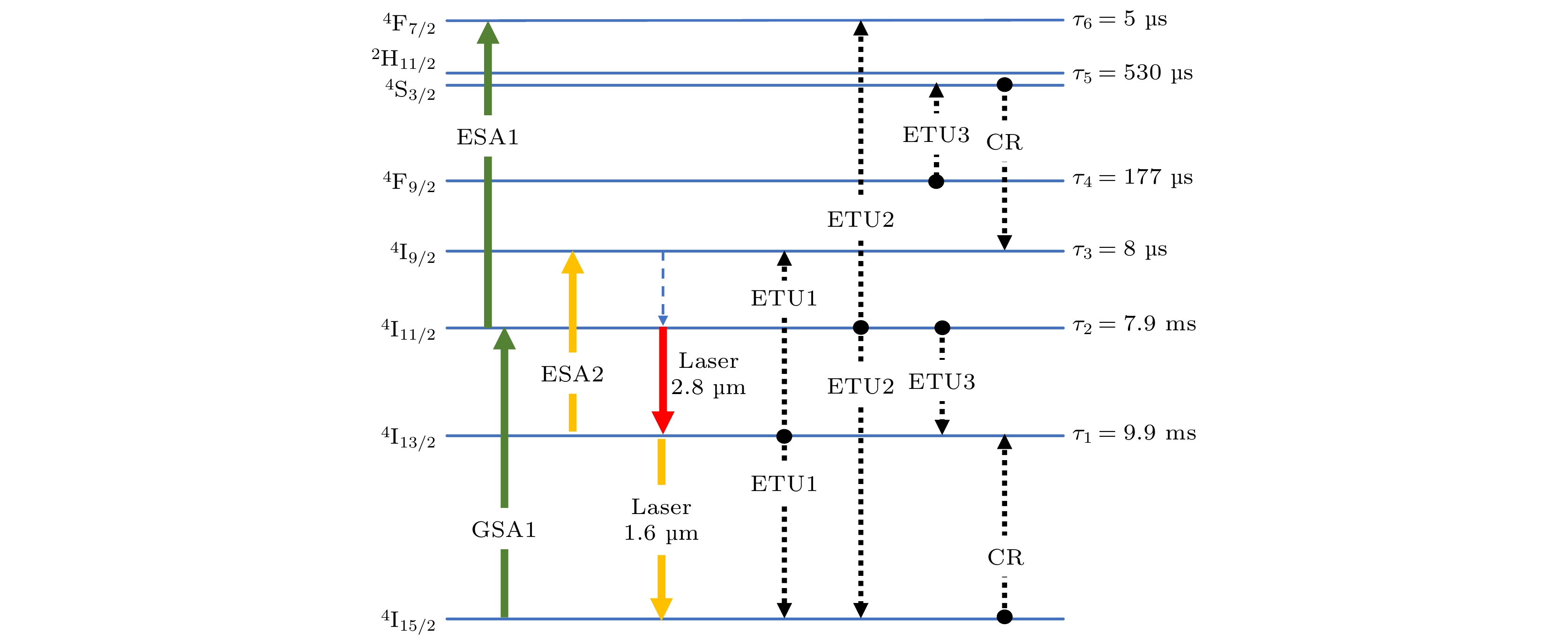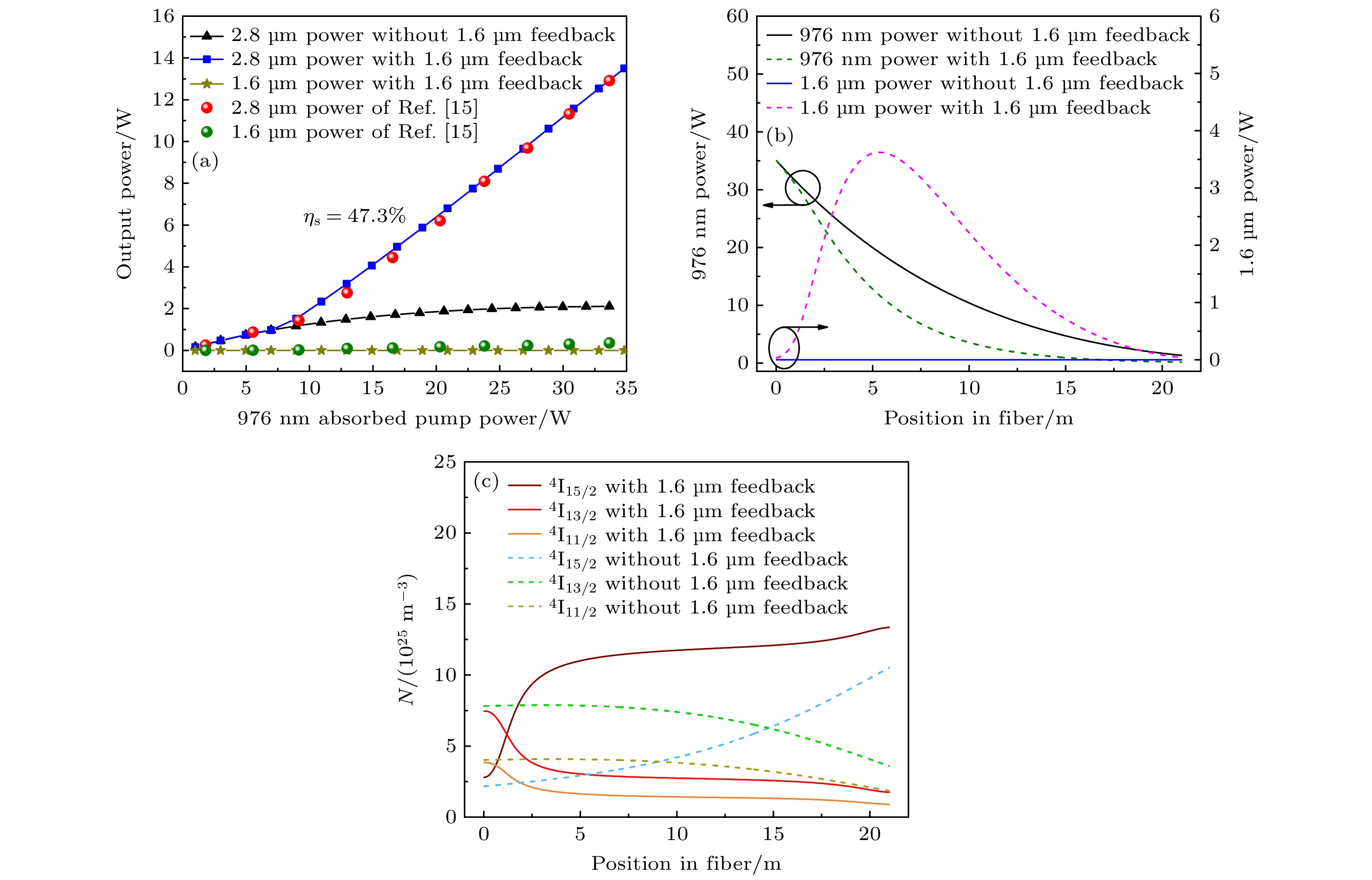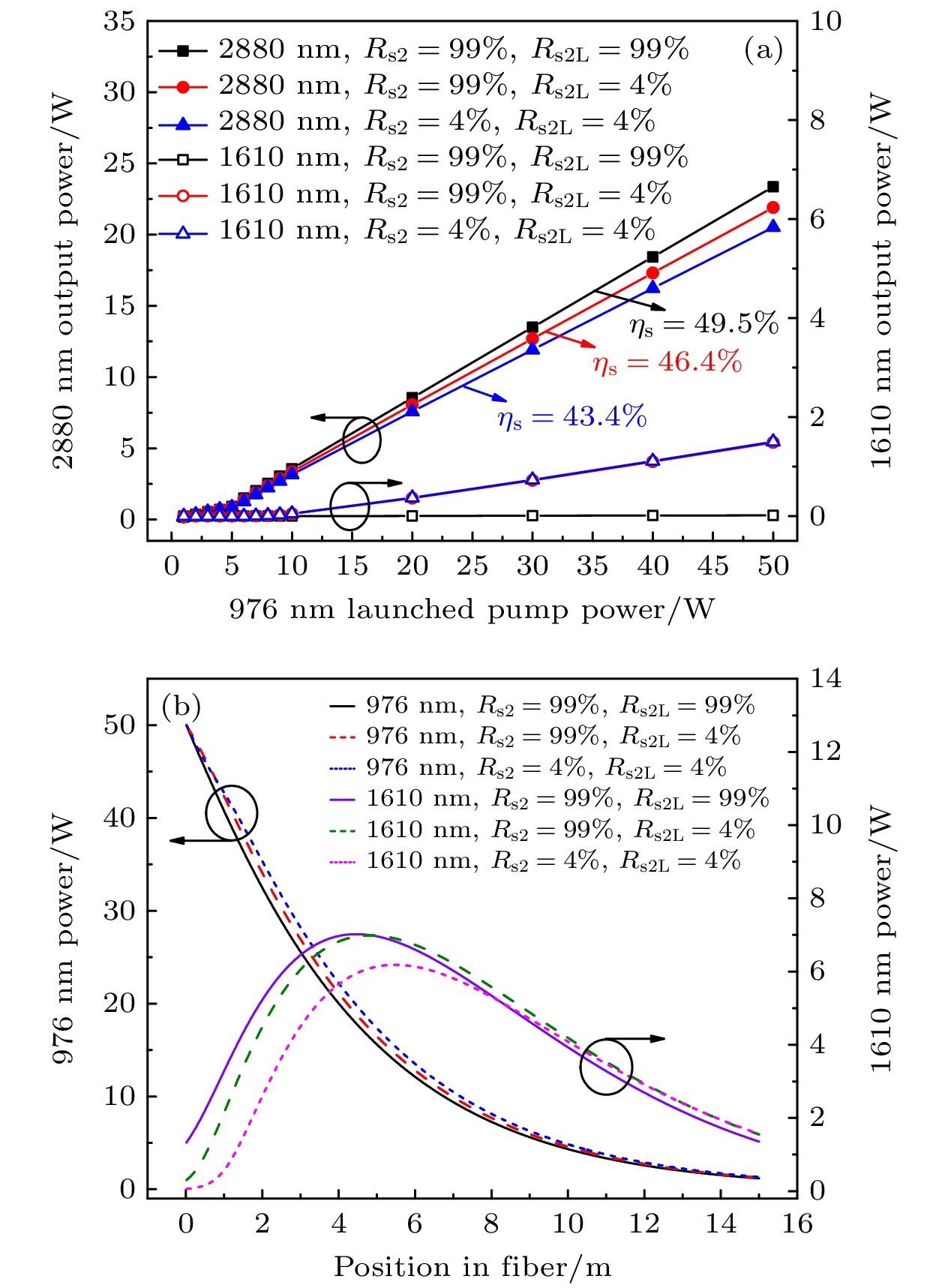-
2.8 μm和1.6 μm激光级联跃迁的工作方式, 可以有效解决低掺铒氟化物光纤中自终止效应导致的2.8 μm激光功率提升难题. 建立基于低掺铒氟化物光纤2.8 μm和1.6 μm激光级联跃迁的中红外光纤激光器数值模型, 系统分析了2.8 μm和1.6 μm激光波长对2.8 μm激光功率和转换效率的影响. 计算结果表明, 选取1610 nm作为级联激光工作波长, 能有效平衡2.8 μm激光下能级4I13/2粒子向基态4I15/2和激发态4I9/2的跃迁过程, 实现2.8 μm波段激光输出功率和效率的提升. 此外, 计算了1.6 μm激光腔反馈对2.8 μm激光功率和效率的影响, 结果表明, 仅通过光纤端面提供的弱反馈即可实现1.6 μm激光振荡, 从而获得高效率2.8 μm激光输出.Er3+-doped ZBLAN fiber laser is a promising approach to producing 2.8 μm mid-infrared (MIR) laser. The long lifetime of the lower-laser-level 4I13/2 often results in serious self-terminating effect which harms the laser power and efficiency significantly, especially for the active fiber with low dopant concentration which is preferred for weak thermal issues but cannot depopulate the lower-laser-level effectively via the up-conversion process. The 1.6 μm lasing (4I13/2 → 4I15/2) in Er-ZBLAN fiber could deplete the population on 4I13/2. Therefore, cascaded 2.8 μm and 1.6 μm lasing in Er3+-doped ZBLAN fiber provides a promising solution to the self-termination effects on laser power scaling. Moreover, the 4I13/2 → 4I15/2 1.6 μm laser also has some overlap with the 4I13/2 → 4I9/2 excited state absorption (ESA) spectrum. The ions on the 4I9/2 level would then relax to the upper-laser-level of 2.8 μm lasing (4I11/2), and results in enhanced laser efficiency. In general, the 1.6 μm cascaded lasing in 2.8 μm Er-ZBLAN fiber laser involves both lasing and ESA. The two processes have different spectra and different influences on the 2.8 μm laser gain. Therefore, there should exist an optimal wavelength of the 1.6 μm laser, which would balance the two processes, ensuring the lower-laser-level depopulation while maximizing the ion recycling. Therefore, we develop a comprehensive numerical model of cascaded 2.8 μm and 1.6 μm lasers based on Er-ZBLAN fiber. After the numerical model is verified by the previous experimental results, the effects of MIR and 1.6 μm lasing wavelengths on the power and conversion efficiency of 2.8 μm laser are investigated in depth. The results show that a suitable trade-off between the two processes can be reached with the cascaded lasing wavelength of 1610 nm, for the optimized 2.8 μm laser power/efficiency. Moreover, the influence of 1.6 μm laser cavity feedback on the power/efficiency characteristics of the 2.8 μm laser is also investigated. It is found that the feedback at 1.6 μm is very low, even only 4% is provided by the Fresnel reflection of the fiber facet, which can effectively generate 1.6 μm laser and significantly improve the efficiency of 2.8 μm laser.
-
Keywords:
- mid-infrared laser /
- fiber laser /
- cascaded laser /
- erbium-doped fluoride fiber
[1] Picqué N, Hänsch T W 2019 Opt. Photonics News 30 26
 Google Scholar
Google Scholar
[2] Jackson S D, Lauto A 2002 Lasers Surg. Med. 30 184
 Google Scholar
Google Scholar
[3] Mahulikar S P, Sonawane H R, Arvind Rao G 2007 Prog. Aerosp. Sci. 43 218
 Google Scholar
Google Scholar
[4] Wu Y, Liang S, Fu Q, Bradley T D, Poletti F, Richardson D J, Xu L 2022 Opt. Lett. 47 3600
 Google Scholar
Google Scholar
[5] Su L B, Guo X S, Jiang D P, Wu Q H, Qin Z P, Xie G Q 2018 Opt. Express 26 5558
 Google Scholar
Google Scholar
[6] Yao Y, Hoffman A J, Gmachl C F 2012 Nature Photon. 6 432
 Google Scholar
Google Scholar
[7] Henderson-Sapir O, Munch J, Ottaway D J 2016 Opt. Express 24 6869
 Google Scholar
Google Scholar
[8] Quimby R S, Miniscalco W J 1989 Appl. Opt. 28 14
 Google Scholar
Google Scholar
[9] Fortin V, Bernier M, Bah S T, Vallée R 2015 Opt. Lett. 40 2882
 Google Scholar
Google Scholar
[10] Goya K, Uehara H, Konishi D, Sahara R, Murakami M, Tokita S 2019 Appl. Phys. Express 12 102007
 Google Scholar
Google Scholar
[11] Aydin Y O, Fortin V, Vallée R, Bernier M 2018 Opt. Lett. 43 4542
 Google Scholar
Google Scholar
[12] 张钧翔, 付士杰, 盛泉, 夏文新, 张露, 史伟, 姚建铨 2023 中国激光 50 0715001
 Google Scholar
Google Scholar
Zhang J X, Fu S J, Sheng Q, Xia W X, Zhang L, Shi W, Yao J Q 2023 Chin. J. Lasers 50 0715001
 Google Scholar
Google Scholar
[13] Jackson S D, Pollnau M, Li J F 2011 IEEE J. Quantum Electron. 47 471
 Google Scholar
Google Scholar
[14] Li J F, Wang L L, Luo H Y, Xie J T, Liu Y 2016 IEEE Photonic. Tech. L. 28 673
 Google Scholar
Google Scholar
[15] Aydin Y O, Fortin V, Maes F, Jobin F, Jackson S D, Vallée R, Bernier M 2017 Optica 4 235
 Google Scholar
Google Scholar
[16] Li J F, Luo H Y, Liu Y, Zhang L, Jackson S D 2014 IEEE J. Sel. Top. Quantum Electron. 20 15
 Google Scholar
Google Scholar
[17] Guo C Y, Lin J P, Tang Z Y, Li K Y, Tu L S, Wang J C, Liu X, Ruan S C 2022 J. Light. Technol. 40 4397
 Google Scholar
Google Scholar
[18] Wang B, Cheng L H, Zhong H Y, Sun J S, Tian Y, Zhang X Q, Chen B J 2009 Opt. Mater. 31 1658
 Google Scholar
Google Scholar
[19] Quimby R S, Miniscalco W J, Thompson B 1992 Proc. SPIE Fiber Laser Sources and Amplifiers III 17 WE3
 Google Scholar
Google Scholar
[20] Ivanova S, PelléF 2009 J. Opt. Soc. Am. B 26 1930
 Google Scholar
Google Scholar
[21] Zhou K M, Zhang L, Chen X F, Mezentsev V, Bennion I 2010 Int. J. Smart Nano Mater. 1 237
 Google Scholar
Google Scholar
-
图 5 2.8 μm激光单谐振腔系统(无1.6 μm腔反馈)与2.8 μm和1.6 μm激光级联跃迁双谐振腔系统(有1.6 μm腔反馈)激光特性对比 (a) 2.8 μm和1.6 μm激光输出功率随泵浦功率的变化; (b) 35 W泵浦功率下泵浦光与1.6 μm级联激光沿光纤的功率分布; (c) 35 W泵浦功率下4I15/2, 4I13/2和4I11/2能级的粒子数沿光纤的分布情况
Fig. 5. 2.8 μm laser characteristics of the 2.8 μm laser single-cavity system (without 1.6 μm feedback) and the dual-cavity system based on cascaded 2.8 μm and 1.6 μm lasers (with 1.6 μm feedback): (a) Output power of 2.8 μm and 1.6 μm laser as a function of 976 nm launched pump power; (b) power distribution of pump light and 1.6 μm cascade laser along fiber under 35 W of launched pump power; (c) population distribution of 4I15/2, 4I13/2 and 4I11/2 energy levels along active fiber under 35 W of launched pump power
图 6 泵浦功率为50 W时 (a) 2.8 μm波段不同激光波长输出功率随1.6 μm级联激光波长的变化情况; (b)固定级联激光波长为1610 nm, 2.8 μm波段不同激光波长输出功率变化情况; (c) 2880 nm和1610 nm激光级联跃迁输出功率随泵浦功率的变化关系. 图中2.8 μm谐振腔反射率为99%和4%, 1.6 μm谐振腔反射率均为99%
Fig. 6. Under 50 W of launched pump power at 976 nm: (a) 2.8 μm output power as a function of cascaded wavelength at 1.6 μm; (b) 2.8 μm output power as a function of laser wavelength at 2.8 μm, the value of cascaded wavelength was fixed at 1610 nm; (c) output power of 2880 nm and 1610 nm laser as a function of 976 nm launched pump power. 2.8 μm cavity feedbacks: Rs1 = 99%, Rs1L = 4%, 1.6 μm cavity feedbacks: Rs2 = 99%, Rs2L = 99%.
图 7 不同1610 nm腔反馈(Rs2/Rs2L)下 (a) 2880 nm和1610 nm激光输出功率随泵浦功率的变化关系; (b) 泵浦功率为50 W时, 泵浦光和1610 nm激光沿光纤的功率分布
Fig. 7. With the different 1610 nm feedbacks (Rs2/Rs2L): (a) Output power of 2880 nm and 1610 nm laser as a function of 976 nm launched pump power; (b) 976 nm and 1.6 μm laser power distribution along active fiber under 50 W of launched pump power.
Parameter Value Parameter Value λp/nm 976 Rp 0.04 λs1/nm 2800 RpL 0.04 σ02/(10–25 m2) 2.00 W1103/(10–24 m3·s–1) 0.40 σ26/(10–25 m2) 1.10 W2206/(10–24 m3·s–1) 0.08 σ12/(10–25 m2) 2.50 W4251/(10–24 m3·s–1) 15.0 σ21/(10–25 m2) 4.22 W5031/(10–24 m3·s–1) 0.10 Rs1 0.99 αp/m–1 0.023 Rs1L 0.04 αs1/m–1 0.00345 参数 数值 参数 数值 λs1/nm 2825 σ10/(10–25 m2) 0.55 λs2/nm 1614 σ01/(10–25 m2) 0.12 Rs2 0.80 σ13/(10–25 m2) 0.127 Rs2L 0.995 σ31/(10–25 m2) 0.133 σ12/(10–25 m2) 1.37 αs2/m–1 0.0048 σ21/(10–25 m2) 2.67 — — -
[1] Picqué N, Hänsch T W 2019 Opt. Photonics News 30 26
 Google Scholar
Google Scholar
[2] Jackson S D, Lauto A 2002 Lasers Surg. Med. 30 184
 Google Scholar
Google Scholar
[3] Mahulikar S P, Sonawane H R, Arvind Rao G 2007 Prog. Aerosp. Sci. 43 218
 Google Scholar
Google Scholar
[4] Wu Y, Liang S, Fu Q, Bradley T D, Poletti F, Richardson D J, Xu L 2022 Opt. Lett. 47 3600
 Google Scholar
Google Scholar
[5] Su L B, Guo X S, Jiang D P, Wu Q H, Qin Z P, Xie G Q 2018 Opt. Express 26 5558
 Google Scholar
Google Scholar
[6] Yao Y, Hoffman A J, Gmachl C F 2012 Nature Photon. 6 432
 Google Scholar
Google Scholar
[7] Henderson-Sapir O, Munch J, Ottaway D J 2016 Opt. Express 24 6869
 Google Scholar
Google Scholar
[8] Quimby R S, Miniscalco W J 1989 Appl. Opt. 28 14
 Google Scholar
Google Scholar
[9] Fortin V, Bernier M, Bah S T, Vallée R 2015 Opt. Lett. 40 2882
 Google Scholar
Google Scholar
[10] Goya K, Uehara H, Konishi D, Sahara R, Murakami M, Tokita S 2019 Appl. Phys. Express 12 102007
 Google Scholar
Google Scholar
[11] Aydin Y O, Fortin V, Vallée R, Bernier M 2018 Opt. Lett. 43 4542
 Google Scholar
Google Scholar
[12] 张钧翔, 付士杰, 盛泉, 夏文新, 张露, 史伟, 姚建铨 2023 中国激光 50 0715001
 Google Scholar
Google Scholar
Zhang J X, Fu S J, Sheng Q, Xia W X, Zhang L, Shi W, Yao J Q 2023 Chin. J. Lasers 50 0715001
 Google Scholar
Google Scholar
[13] Jackson S D, Pollnau M, Li J F 2011 IEEE J. Quantum Electron. 47 471
 Google Scholar
Google Scholar
[14] Li J F, Wang L L, Luo H Y, Xie J T, Liu Y 2016 IEEE Photonic. Tech. L. 28 673
 Google Scholar
Google Scholar
[15] Aydin Y O, Fortin V, Maes F, Jobin F, Jackson S D, Vallée R, Bernier M 2017 Optica 4 235
 Google Scholar
Google Scholar
[16] Li J F, Luo H Y, Liu Y, Zhang L, Jackson S D 2014 IEEE J. Sel. Top. Quantum Electron. 20 15
 Google Scholar
Google Scholar
[17] Guo C Y, Lin J P, Tang Z Y, Li K Y, Tu L S, Wang J C, Liu X, Ruan S C 2022 J. Light. Technol. 40 4397
 Google Scholar
Google Scholar
[18] Wang B, Cheng L H, Zhong H Y, Sun J S, Tian Y, Zhang X Q, Chen B J 2009 Opt. Mater. 31 1658
 Google Scholar
Google Scholar
[19] Quimby R S, Miniscalco W J, Thompson B 1992 Proc. SPIE Fiber Laser Sources and Amplifiers III 17 WE3
 Google Scholar
Google Scholar
[20] Ivanova S, PelléF 2009 J. Opt. Soc. Am. B 26 1930
 Google Scholar
Google Scholar
[21] Zhou K M, Zhang L, Chen X F, Mezentsev V, Bennion I 2010 Int. J. Smart Nano Mater. 1 237
 Google Scholar
Google Scholar
计量
- 文章访问数: 5390
- PDF下载量: 101
- 被引次数: 0














 下载:
下载:






